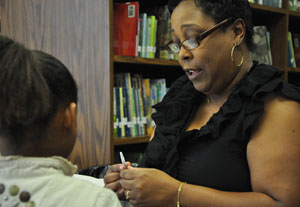Maryland Schools Start H1N1 Vaccine Distribution in Landover
|
Prince George's County Health Department Nurse Cecelia Robinson prepares to administer FluMist, the H1N1 vaccine, to a Dodge Park Elementary School student. About 90 students were vaccinated Friday, says Assistant Principal Victoria Holmes. (Maryland Newsline photo by Kelly Brooks)
|
By Kelly Brooks
Maryland Newsline
Friday, Oct. 9, 2009
LANDOVER, Md. - Nurse Cecelia Robinson gently placed one hand on the crown of a Dodge Park Elementary School student's head. The other hand held an approximately three-inch sprayer that delivered one, then another squirt of FluMist, the H1N1 vaccine, into the student's nostril.
"Your mom's going to be proud," she told the student, smiling. "You didn't sneeze, you didn't cry."
Nine-year-old Dominique Abrams received the vaccine earlier that day. "It was OK," she said. "It just felt weird."
Dodge Park was the first school in the state to receive FluMist, and about 90 students and some teachers were vaccinated Friday, said Victoria Holmes, assistant principal of the Landover, Md., school. The school had sent letters home with all students, and parents chose whether they wanted their children to receive the nasal spray. Students who have asthma or received a seasonal flu shot within the past four weeks did not qualify, Holmes said.
Health and Human Services Secretary Kathleen Sebelius, U.S. Education Secretary Arne Duncan and Maryland Gov. Martin O'Malley visited Dodge Park early Friday to underscore the importance of swine flu vaccinations for children.
Some parents were apprehensive about FluMist and did not sign the form, but others seemed happy about the clinics because of the swine flu deaths that have already occured, Holmes said.
Ten-year-old Dodge Park student Jiyana Buie said she was "a little nervous" about the vaccine, but she still got it. She was more worried about catching H1N1 "because I've heard that people died from it, and it's spreading."
There have been no reported student or teacher cases of swine flu at Dodge Park Elementary School, Holmes said.
Forty-eight schools in Maryland have likely experienced H1N1 outbreaks, Maryland Department of Health and Mental Hygeine spokesman David Paulson said. Outbreaks have a complex, two-part definition, he said:
- at least five kids report flu-like illnesses -- as seen by the school medical office -- within a 48-hour period, and
- the school's baseline absenteeism for flu-like illness doubles within 48 hours; or
- there is a 25 percent or substantial increase in flu-like illness, or
- a substantial cluster of students exhibit flu-like illness in a classroom or on an athletic team.
State officials do not have an exact tally on the number of infected students because most people who likely get H1N1 are not tested for it, Paulson said.
But of those who have been tested, "about 98 percent of what we are seeing is H1N1 flu," he said.
He added: "We always knew that the emphasis wouldn't be on confirming if it's H1N1, but treating the patient."
Debbie Ritchie, president of the Maryland Parent-Teacher Association, said neither parents nor teachers seem to be "freaking out" about the H1N1 pandemic.
"They're vigilant," she said. "They know what the signs and symptoms are."
One public school - the SEED School of Maryland - has closed this fall due to staff illnesses, Paulson said. SEED, a 160-student sixth- and seventh-grade public boarding school in Southwest Baltimore, closed for three days in late September, Paulson said.
"They did not have enough staff to adequately supervise a 24-hour boarding school," he said, adding there was "no confirmation" that any staff members actually had H1N1.
Local school boards make closure recommendations to state schools Superintendent Nancy S. Grasmick, who in turn confers with Maryland Department of Health and Mental Hygeine Secretary John M. Colmers.
Colmers holds the final closure say, which "will likely rest on absenteeism and the numbers as they fit any particular school," Paulson said. "It could be a teacher and support staff absentee issue as well."
When H1N1 started spreading last spring, one confirmed H1N1 case meant a school could close for two weeks, and seven Maryland public schools closed, Paulson said.
"That hasn't been the policy since May," he said. The standard changed once experts learned H1N1 was not as dangerous as first suspected.
For now, county officials are planning distribution clinics like the one at Dodge Park.
More schools could have clinics as early as next week, Paulson said.
Frederick County officials, who do not have enough vaccine supply to vaccinate all schools at once, will be using a lottery system to decide the order in which schools will host clinics, according to an Oct. 7 news release.
Vaccine supply, Paulson said, starts as a trickle, then "becomes a stream, becomes a river." |

